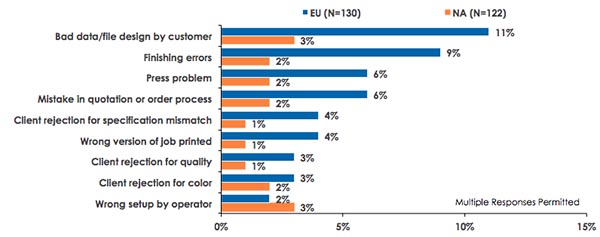- Although 62% of respondents attributed growth to faster and more efficient equipment, only 31% believed that growth was attributable to investments in software that increased automation.
- Costs and errors associated with waste must be controlled and automated, and integrated software is critical for minimizing their impact.
- A number of waste streams can be minimizedor nearly eliminated by implementing software solutions or making better use of existing ones.
By Ryan McAbee
Introduction
Today’s printers understand that they must automate their print operations. In fact, recent research from Keypoint Intelligence – InfoTrends reveals that 39% of respondents in North America want to improve business automation within their print shops for 2019. At the same time, however, 43% of these respondents have all or mostly manual processes in their print production. A biasseems to exist between the potential benefits of investing in equipment vs. software. Many respondents (62%) attributed growth to the addition of faster and more efficient equipment, yet only 31% believed that growth was attributable to investments in software that increased automation.
Production Errors Add Up Quickly!
Workflow costs due to production errors, while seemingly insignificant, can quickly compound over the course of a year. Job onboarding and preflighting carrylaborcosts of nearly $115,000—roughly 1.5 full-time employees for most companies. Waste also adds up quickly. In total, waste due to errors within the control of the printer averaged nearly $2.8 million per year. These are costs and errors that must be controlled and automated, and integrated software is critical for minimizing their impact. The highest-rated issue affecting waste in print production—bad customer files and data—is not always under the printer’s control. Nevertheless, printers should have software (mainly preflighting) and manual controls in place for quality assurance.
It is interesting to note that North American printers report a much smaller percentage of waste from 10 common print production issues than their European counterparts. This may be because North American printers are better at identifying errors upstream, or perhaps they have better quality checks and balances in place. Another plausible theory could be that North American printers’ systems (handling shop floor data collection, for example) are not detailed enough to accurately account for their waste streams. We’ve all heard the adage that you can’t manage what you can’t measure, and that certainly applies here!
Figure 1. Common Print Production Issues

Base: Total Respondents in North America and Europe
Source: EU & NA Production Software Investment Outlook; Keypoint Intelligence – InfoTrends 2019
A number of these waste streams can be minimizedor nearly eliminated by implementing software solutions or making better use of existing ones. Meanwhile, others need a repeatable set of Quality & Assurance (Q&A) procedures. Specifically:
- A standard and repeatable job onboarding process that captures all of the customer’s intent and related files, regardless of how the order was placed, can have a big impact. Thorough job onboarding reduces the probability of a mistake in the quote/order submission and later rejection by the client due to a specification mismatch.
- Implementing and mandating the use of consistently updated electronic job tickets ensures that all production staff members are following the latest approved changes to the order. This also increases the likelihood that the correct versions of files will be printed.
- In-line or offline spectrophotometers with a colormanagement system can measure and validate that the print is within the established colortolerance/specification, and they are an impartial tool for validating that the coloris acceptable. Procedures that implement checklists for all jobs performed by printing and finishing operators should catch most, if not all, other manufacturing defects. This makes it possible to address issues before the finished products are delivered to customers.
The Bottom Line
Although much attention is rightfully paid to the topic of workflow efficiency through automation, waste is an equally important issue that is likely eating away at your bottom line. Identifying waste can be elusive, but making the best use of time, materials, and labor on the shop floor can make a real difference in your print operations. Now is the time to implement processes, procedures, and software to accurately measure waste and improve quality control. This could represent a multimillion-dollar improvement!
Ryan McAbee is a Director for Keypoint Intelligence - InfoTrends' Production Workflow Consulting Service, which focuses on providing technology, business, and market insights to clients in the Digital Marketing & Media and Production Workflow markets. In this role, he is responsible for conducting market research, market analysis and forecasting, content development, industry training, and consulting with print service providers.










Discussion
Join the discussion Sign In or Become a Member, doing so is simple and free